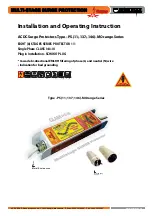
Glossary
GLOSSARY
Common address
Projector will always execute the command coming from a RCU programmed with that common address.
Default Gateway
A router that serves as an entry point into and exit point out of a network. For example, a local network (LAN) may need a gateway
to connect it to a wide area network (WAN) or to the Internet.
DHCP
Dynamic host con
fi
guration protocol. DHCP is a communications protocol that lets network administrators manage centrally and
automate the assignment of IP addresses in an organization’s network. Using the Internet Protocol, each machine that can connect
to the Internet needs a unique IP address. When an organization sets up its computer users with a connection to the Internet,
an IP address must be assigned to each machine. Without DHCP, the IP address must be entered manually at each computer
and, if computers move to another location in another part of the network, a new IP address must be entered. DHCP lets a network
administrator supervise and distribute IP addresses from a central point and automatically sends a new IP address when a computer
is plugged into a different place in the network.
DMX
DMX-512 Lighting protocol over RS-485 interface. Carries information of 512 channels from a lighting controller to lighting devices.
Standardized by USITT.
HD
Hazard Distance (HD) is the distance measured from the projection lens at which the intensity or the energy per surface unit becomes
lower than the applicable exposure limit on the cornea or on the skin. The light beam is considered (to be) unsafe for exposure if
the distance from a person to the light source is less than the HD.
–8
IP
Internet Protocol. The network layer of TCP/IP. Required for communication with the internet.
Light processor unit
Heart of the projector, unit inside this projector which is responsible for the creation of the image to be projected on the screen. Also
called ’engine’.
MAC address
Media Access Control address. Unique hardware number, used in combination with the IP-address to connect to the network (LAN
or WAN).
Projector address
Address installed in the projector to be individually controlled.
–52
RS232
An Electronic Industries Association (EIA) serial digital interface standard specifying the characteristics of the communication path
between two devices using either D-SUB 9 pins or D-SUB 25 pins connectors. This standard is used for relatively short-range
communications and does not specify balanced control lines. RS-232 is a serial control standard with a set number of conductors,
data rate, word length and type of connector to be used. The standard speci
fi
es component connection standards with regard to
computer interface. It is also called RS-232-C, which is the third version of the RS-232 standard, and is functionally identical to the
CCITT V.24 standard. Logical ’0’ is > + 3V, Logical ’1’ is < - 3V. The range between -3V and +3V is the transition zone.
RS422
An EIA serial digital interface standard that speci
fi
es the electrical characteristics of balanced (differential) voltage, digital interface
circuits. This standard is usable over longer distances than RS-232. This signal governs the asynchronous transmission of computer
data at speeds of up to 920,000 bits per second. It is also used as the serial port standard for Macintosh computers. When the
difference between the 2 lines is < - 0.2V that equals with a logical ’0’. When the difference is > +0.2V that equals to a logical ’1’..
R5906070 HDX 4K 23/09/2016
99






































